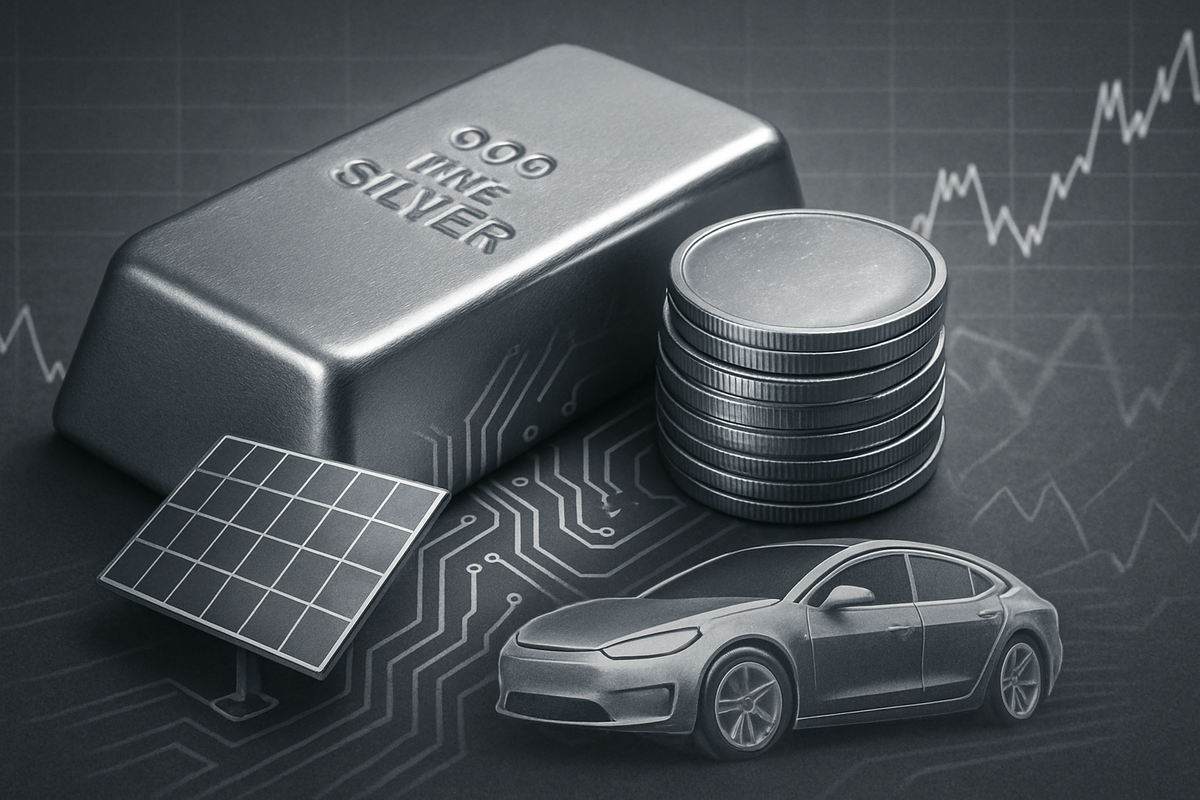
The global financial markets are currently gripped by the extraordinary volatility in silver prices, which have seen a massive upward trajectory in 2025, culminating in multi-year and even all-time highs around October. This dramatic surge has captivated investors, driven by a powerful confluence of robust industrial demand, persistent supply deficits, and a supportive macroeconomic environment. However, the rally's intensity has been matched by equally sharp corrections, as evidenced by a significant single-day plunge on October 17, 2025, leaving market participants questioning the sustainability of the ascent and its immediate implications for investment strategies.
This unprecedented movement in the "poor man's gold" signifies a critical juncture for both the precious metals sector and the broader industrial landscape. For investors, the immediate challenge lies in navigating the heightened volatility, balancing the allure of substantial gains with the risks of rapid pullbacks. The underlying forces at play suggest a potential structural repricing of silver, moving beyond mere speculative interest to reflect its increasing strategic importance in a rapidly evolving global economy.
The Silver Rollercoaster: A Detailed Look at the Recent Surge and Correction
Silver's journey in 2025 has been nothing short of spectacular, marked by a relentless upward climb that saw prices breach the $52.50 per ounce mark, touching an all-time high of $54.17 earlier in October. This represented an astounding 76% year-to-date gain, significantly outpacing gold's impressive 55% increase over the same period and marking silver's strongest rally since 2011. In key markets like India, silver prices soared past ₹1.89 lakh per kilogram in major cities, even reaching ₹2 lakh in Chennai, Hyderabad, and Kerala by October 17, 2025, with a notable ₹6,000 jump between October 13 and 14 alone. The MCX Silver futures contract was robustly trading around ₹1,60,000 as of October 16, 2025.
However, the rally's dizzying heights were met with a dramatic reality check. On October 17, 2025, silver prices experienced a sharp correction, plunging over 6% in a single session to $50.96 per ounce. This marked the steepest one-day decline since April 2025 and was primarily attributed to widespread profit-taking by investors, a shift in overall risk sentiment, and technical corrections following an extended period of overbought conditions. This immediate reaction underscored the metal's inherent volatility and the speculative elements at play alongside its strong fundamentals.
The primary drivers behind this monumental surge are multifaceted. Firstly, soaring industrial demand has emerged as a critical structural catalyst. Silver is indispensable in the rapidly expanding renewable energy sector, particularly in solar panels, as well as in electronics, electric vehicles (EVs), 5G technology, and advanced sensors. Global investment in green infrastructure and electrification has created a significant and growing demand base, with industrial use projected to account for over 700 million ounces in 2025, representing an estimated 59% of total demand in 2024.
Secondly, the market is grappling with persistent supply deficits and physical shortages. 2025 marks the fifth consecutive year where global silver consumption is set to outstrip supply, leading to an estimated structural deficit of around 118 million ounces. Tight liquidity in major trading hubs like London and New York, coupled with soaring lease rates (exceeding 30%), points to an acute scarcity of deliverable metal. Reports of physical shortages are widespread, from India (where imports dropped by 42% in 2025 despite surging demand) to China, Turkey, and Australia. A significant challenge to increasing supply is that approximately three-quarters of global silver output is a by-product of mining other metals, making it difficult to rapidly scale up production in response to rising silver prices alone. This inelasticity, combined with market backwardation reaching an unusual 20% annualized rate on October 10, 2025, further emphasizes the severe scarcity of physical silver.
Finally, several macroeconomic catalysts have provided a strong tailwind. Expectations of a Federal Reserve interest rate reduction (with a 96.8% probability of a 25-basis-point cut) have generally weakened the U.S. dollar and reduced bond yields, making non-yielding assets like silver more attractive. Persistent concerns over inflation and accelerating currency devaluation are driving investors towards precious metals as a hedge. Geopolitical instability, including ongoing regional conflicts and escalating trade tensions, has also fostered safe-haven demand. Broader economic uncertainties, such as a prolonged U.S. government shutdown and weakening macroeconomic indicators, further amplify the appeal of tangible assets. This confluence of fundamental industrial demand, supply constraints, and macroeconomic support has set the stage for silver's dramatic performance.
Companies Navigating the Silver Wave: Winners and Losers
The surge in silver prices presents a mixed bag of fortunes for public companies across various sectors. The most direct beneficiaries are, naturally, silver mining companies and those involved in precious metals streaming. These entities stand to see significant boosts to their revenues and profitability as the value of their primary product escalates.
Among the prominent winners are major silver producers like Pan American Silver Corp. (NYSE: PAAS, TSX: PAAS), one of the world's largest primary silver producers with extensive operations across the Americas. Similarly, First Majestic Silver Corp. (NYSE: AG, TSX: AG), known for its focused silver production primarily in Mexico, is considered a "pure-play" on silver in the mining sector and benefits directly from increased prices. Fresnillo Plc (LSE: FRES), the world's largest primary silver producer operating mines in Mexico, is also poised for strong revenue and margin growth. Other significant beneficiaries include Hecla Mining Company (NYSE: HL), with substantial silver operations in the U.S. and Mexico, and mid-tier players like Endeavour Silver Corp. (TSX: EDR, NYSE: EXK) and MAG Silver Corp. (NYSE: MAG), which is focused on high-grade deposits like its Juanicipio mine in Mexico. Even diversified miners like Hindustan Zinc Ltd (NSE: HINDZINC), the world's third-largest silver producer, and its parent Vedanta Ltd (NSE: VEDL), will see enhanced profitability from their silver segments.
Precious metals streaming companies also stand to gain substantially. Wheaton Precious Metals Corp. (NYSE: WPM), for instance, provides upfront payments to miners in exchange for future silver and gold production at fixed, low prices. A surge in spot silver prices directly increases the value of the silver Wheaton is entitled to, significantly boosting its revenue without the operational risks of mining. This model allows them to capitalize on price increases with greater leverage.
On the other side of the coin, industries heavily reliant on silver as a critical industrial input could face significant margin pressure, especially if they cannot fully pass on increased costs to consumers or if they operate on fixed-price contracts. Solar panel manufacturers are among the most exposed, as silver is an essential component in photovoltaic cells. Companies like First Solar, Inc. (NASDAQ: FSLR), while actively researching alternative materials like copper, face rising production costs. The share of silver in solar module production costs has reportedly surged to an estimated 14% in 2025, up from 5% in 2023, exacerbating cost pressures and potentially impacting project viability.
The broader electronics industry also consumes a substantial portion of global silver for electrical contacts, solders, and switches due to its superior conductivity. While specific "pure-play" electronics companies are not singled out, the sector as a whole will contend with elevated raw material costs, potentially squeezing profit margins for manufacturers with extensive operations that rely on silver components. Similarly, electric vehicle (EV) manufacturers utilize significantly more silver than traditional internal combustion engine vehicles, with an electric car typically containing 1 to 2 ounces of silver. This means that a sustained increase in silver prices would raise manufacturing costs across the EV sector, impacting companies like Tesla (NASDAQ: TSLA) or General Motors (NYSE: GM), though their diversified product lines might buffer the impact. The rising demand for EVs, however, also drives the demand for silver, creating a complex and intertwined dynamic for these industries.
Wider Significance: Silver's Role in a Shifting Global Landscape
The dramatic movements in silver prices around October 2025 are not isolated events but rather deeply embedded within broader industry trends and macroeconomic shifts. This surge highlights silver's evolving role, transitioning from a mere precious metal to a critical strategic commodity at the heart of the global green energy transition and technological advancement.
The most significant broader trend is the accelerating global push towards decarbonization and electrification. Silver is a cornerstone of this movement, being indispensable for solar photovoltaics, electric vehicle components, and advanced electronics crucial for 5G and AI infrastructure. The sustained industrial demand, projected to account for a growing share of total consumption, suggests a fundamental repricing of silver based on its utility, rather than purely speculative interest. This trend implies potential ripple effects across various sectors: an increase in solar project costs could slow adoption or necessitate greater government subsidies, while rising EV manufacturing expenses could impact consumer affordability and industry growth trajectories. Conversely, it incentivizes research into silver-reducing technologies or alternative materials, although such transitions are often slow and costly.
Regulatory and policy implications, while not directly addressed by the immediate price movements, are intrinsically linked to the demand drivers. Government incentives for renewable energy and EV adoption, along with commitments to digital infrastructure, directly fuel silver consumption. Any shifts in these policies – either through increased support or unexpected cutbacks – could significantly impact long-term silver demand. Furthermore, increasing awareness of supply chain vulnerabilities for critical minerals might prompt governments to consider strategic stockpiling or incentivize domestic mining, though silver's by-product nature makes this complex.
Historically, silver rallies have often been more volatile and speculative than gold's, earning it the moniker "gold on steroids" due to its higher beta. The current rally draws parallels to the 2011 surge when silver briefly touched nearly $50 per ounce. However, a key difference now is the robust underlying industrial demand. Unlike past rallies driven predominantly by monetary concerns and speculative fervor, the current environment sees fundamental supply-demand imbalances driven by tangible industrial applications. This suggests the current repricing could be more sustainable in the long term, even with short-term corrections. The gold/silver ratio, which has seen silver outperform gold significantly in 2025, also suggests that silver may still be undervalued relative to its yellow counterpart, hinting at further potential for catch-up.
What Comes Next: Navigating Silver's Future Trajectory
The future trajectory of silver prices is expected to remain highly dynamic, influenced by a complex interplay of market fundamentals, macroeconomic shifts, and investor sentiment. In the short-term, heightened volatility is likely to persist. The dramatic correction on October 17, 2025, serves as a potent reminder that profit-taking and technical adjustments will punctuate any upward movement. Analysts widely anticipate further short-term corrections as the market digests recent gains and technical indicators signal overbought conditions. However, the prevailing sentiment among many experts is to "buy on dips," indicating a belief in the underlying bullish momentum.
Looking to the long-term, the outlook for silver remains overwhelmingly bullish. The structural demand from green energy, electrification, and technology sectors is not a fleeting trend but a fundamental shift in global industrial consumption. Analysts are forecasting a multi-year bull run, with some projecting prices to reach $70 per ounce by the end of 2025, $90 by the end of 2026, and potentially even $200-$300 per ounce by 2030-2037. These ambitious targets underscore the profound impact of sustained industrial demand coupled with persistent supply deficits.
Potential strategic pivots or adaptations will be required across industries. For silver-consuming sectors like solar and EVs, intensified research into alternative materials and efficiency improvements in silver usage will become paramount to mitigate rising input costs. Mining companies, particularly those with significant silver by-product, may face pressure to optimize their operations to capitalize on higher prices while managing overall production costs. For investors, market opportunities may emerge not only in direct silver exposure (physical metal, ETFs, mining stocks) but also in companies innovating in silver-replacement technologies or those demonstrating superior cost management in silver-intensive industries.
Several potential scenarios could unfold. A "green revolution" scenario, where global investment in renewable energy and EVs accelerates beyond current projections, could push silver prices even higher, faster. Conversely, a significant global economic slowdown or a sharp reversal in green energy policies could temper industrial demand, leading to more moderate price appreciation or even prolonged consolidation. Geopolitical stability or a more hawkish stance from central banks (less likely given current rate cut expectations) could also reduce safe-haven demand. However, the current confluence of factors strongly points towards a sustained upward revaluation, making silver a compelling, albeit volatile, asset to watch.
Comprehensive Wrap-up: A New Era for Silver
The recent massive move in silver prices, culminating in unprecedented highs and subsequent sharp corrections around October 2025, marks a pivotal moment for the precious metal. The key takeaway is that silver's role is undergoing a significant transformation. It is no longer solely a monetary asset or a speculative play; it has firmly established itself as a critical industrial commodity essential for the global transition to a greener, more technologically advanced future.
Moving forward, the market will likely be characterized by continued volatility, offering both substantial opportunities and considerable risks for investors. The underlying fundamentals—soaring industrial demand from solar, EVs, and electronics, coupled with persistent supply deficits and supportive macroeconomic conditions—suggest that the long-term bullish narrative for silver remains intact. However, the sharp 6% decline on October 17, 2025, underscores the importance of robust risk management and a nuanced understanding of market dynamics, distinguishing between fundamental drivers and short-term speculative movements.
Investors should watch for several key indicators in the coming months. These include continued data on industrial demand, particularly from the renewable energy and EV sectors, updates on global silver mining output and supply chain health, and any shifts in central bank monetary policy or geopolitical tensions. The Gold/Silver Ratio will also be a critical metric, as silver's historical tendency to outperform gold in bull markets suggests further potential for relative gains. Ultimately, silver appears poised for a new era, where its dual nature as both a precious metal and an indispensable industrial input will continue to drive its market performance, making it a compelling, albeit challenging, asset for strategic investment.
This content is intended for informational purposes only and is not financial advice








